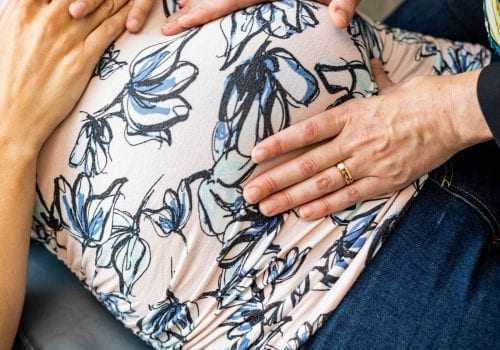
Motherhood can be a pain in the neck, literally. The weight of pregnancy mixed with labor and delivery can cause all types of issues. Throw in the postpartum struggle of carrying a diaper bag, car seat, constant stress and sleepless nights, and you have a recipe for muscular and spinal disaster. We are going to review the importance of spinal health and why chiropractic care should be a priority for all moms. Pregnancy is a span of time in which a woman’s body undergoes many changes, some changes being more comfortable than others.
What Happens to our Body?
Although we often picture pregnancy as a wonderful expectation in the growth of new life, the physical changes a woman’s body goes through can feel anything but miraculous. Over 50% of pregnant women report their biggest complaint during pregnancy is low back pain, sometimes lasting over 3 months! Additionally, up to three-fourths of women will experience low back pain at some point during their pregnancy.1,2 Add to this pelvic girdle pain, which is experienced by up to 20% of women at some point during pregnancy,3, and it’s no wonder that pregnancy can be physically exhausting! Although pain is usually experienced sometime between the fifth and seventh month of being pregnant, it can begin as soon as eight to twelve weeks after becoming pregnant.2 And as the baby grows, a woman’s center of gravity changes to accommodate, shifting forward to accommodate for the growth of the baby. The abdomen stretches, and the woman’s belly moves forward and out accordingly to increase in the baby’s weight and development; so, too, does the shift in gravity of a woman’s weight3 on her low back, pelvis, knees, ankles, and feet.
In fact, the thoracic (mid-back) and lumbar (low back) spine curvature can change during pregnancy, causing an increase in pain in the low back and pelvic regions. This can also cause alterations to balance and gait patterns.3 Think of the pregnant “waddle” that some women do while walking, and you have an idea as to the changes that take place in the abdomen, low back, pelvis, and sacrum! This can, and often does, place additional stress and strain on the joints in the low back and posterior pelvis, known as the lumbar and sacroiliac areas. These postural changes lead to increased pain, muscle tightness, tenderness, and discomfort.2 Pregnancy can even lead to changes in the curvature of the woman’s spine.
Low back and pelvic pain can also be major deterrents in a woman who could, and would, be otherwise motivated to continue working and taking care of both herself and her home. Pain has shown to influence pregnant women’s daily lives in the challenges they encounter concerning their physiological, psychological, occupational, and social functions.4 And it doesn’t always stop there. Sometimes women can experience low back and pelvic region pain the year after birth, and even up to three years after labor and delivery.1,5 Pregnancy-related low back and pelvic pain, as well as post-partum mechanical spinal disorders, are not only common, but they can impede recovery, nursing, and caregiving – three very important components in taking care of the newborn after labor and delivery.5
The Benefits
I am certified through the Academy of Chiropractic Pediatrics and am Webster Certified. Taking care of women at any stage pre-conception through postpartum is a passion of mine. I bring my professional and personal experiences to the table to help others. There are various benefits of being adjusted during pregnancy including the relief of neck, back, and pelvic pain. Chiropractic care during pregnancy can also encourage optimal fetal position through proper pelvic alignment which supports a natural labor and delivery and can reduce average labor time.
At Venture Chiropractic we have special tables with a drop out section so an expecting mom can comfortably lay on her stomach while being adjusted. From first trimester nausea to third-trimester sciatic pain and even discomfort postpartum, I provide treatment and support throughout every phase of pregnancy. While a chiropractor cannot help with changes in hormones that naturally occur with fetal growth, the resulting biomechanical changes that occur in a woman’s body during pregnancy can be lessened or alleviated by the help of a knowledgeable chiropractor.
Some options for treatment include chiropractic spinal manipulation, soft tissue therapy, exercises, and ergonomic advice. Treatment could improve functional activities such as sitting, traveling comfortably in a car, walking, and more.3 And, addressing this discomfort sooner rather than later is preferred, especially if employment or maternity leave is a concern. Low back pain is the most common cause of sick leave after delivery!7 Maintaining optimal function and reducing pain levels to more manageable levels are goals that should be discussed with a doctor of chiropractic as well as an OBGYN when it comes to pregnancy-related pain.2 A detailed history and clinical examination are essential for determining what biomechanical source is causing a pregnant woman’s low back or pelvic pain.6 A chiropractor can also help identify any areas of stiffness7 that may accumulate in weak areas of the body8, contributing to an increase in back pain during pregnancy. This may be the case if poor posture, excessive standing, and bending over trigger or escalate any back and pelvic pain.
Why Venture?
I strive to help women be the best version of themselves, and we know that starts with their health as the foundation. When moms are able to be their best, they’re able to come from a place of love-instead of stress- with their kids. I meet each person where they are and support them through chiropractic care, exercise, and nutritional support that allows them to function their best. We are always here at Venture to help you move better, feel better, and be a better you!
– Melanie Dockter, DC, CACCP
References
- Yoo, H., Shin, D., and Song, M. (2015). Changes in the spinal curvature, degree of pain, balance ability, and gait ability according to pregnancy period in pregnant and nonpregnant women. J Phys Ther Sci. 2015 Jan; 27(1): 279–284.
- Montgomery, S.P. “Management of back pain during pregnancy.” (2009). Retrieved March 2020 from: https://www.spine-health.com/conditions/pregnancy-and-back-pain/management-back-pain-pregnancy
- Verstraete, V.H., Vanderstraeten, G., and Parewijck, W. (2013). Pelvic Girdle Pain during or after pregnancy: a review of recent evidence and a clinical care path proposal. Facts Views Vis Obgyn. 2013; 5(1): 33–43.
- Bernard, M., and Tuchin, P. (2016). Chiropractic management of pregnancy-related lumbopelvic pain: a case study. J Chiropr Med. 2016 Jun; 15(2): 129–133.
- Maiers, M., et al. (2018). Chiropractic in Global Health and wellbeing: a white paper describing the public health agenda of the World Federation of Chiropractic. Chiropr Man Therap. 2018; 26: 26.
- Katonis, P., et al. (2011). Pregnancy-related low back pain. Hippokratia. Jul-Sep; 15(3): 205–210.
- Sabino, J., and Grauer, J.N. (2008). Pregnancy and low back pain. Curr Rev Musculoskelet Med. 2008 Jun; 1(2): 137–141.
- “Back pain during pregnancy: causes, treatment and prevention.” American Pregnancy Association. Retrieved March 2020 from: https://americanpregnancy.org/pregnancy-health/back-pain-during-pregnancy



